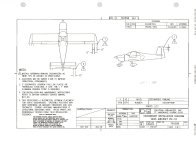Hi there. I have a stock IO-540 with Slick mags, and an RPM sensor installed in the non-impulse magneto.
Normally, my RPM readings are rock solid. On initial climb my prop is turning at 2700 RPM, then I bring it down to 2500 RPM for continued climb.
Last week, I did a fair bit of flying in IMC, and on two occasions (both climbing at 2500 RPM, in cloud and in the rain), I noticed a surge in the indicated RPM, with the readings climbing up beyond 2800 RPM, even reaching 3100 for a few seconds once. But I think this is a sensor problem, not a governor one, since I didn't hear the propeller surge or sound in any way out of the normal (I would think that a real RPM surge from 2500 to 3100 would sound quite noticeable, and the engine sound didn't change noticeably). Still, it was quite disconcerting.
In talking to a magneto manufacturer at Oshkosh, he suggested the events might have been due to precipitation static. That makes some sense to me, I think, since any spurious noise on the RPM sensor line might be interpreted as additional pulses on the sensor. But I'm curious what the rest of you think.
Does this make sense to you? If so, it's an easy "fix" to just ignore intermittent high RPM readings when climbing through precipitation. Or perhaps look into shielding the wires to the sensor better. If not, does this indicate to anyone that I should look into replacing the RPM sensor entirely? I surely hope that it's a sensor problem and not a "real" RPM surge, because I'd definitely rather not consider replacing the governor.
Thanks for any feedback!
Dan
Normally, my RPM readings are rock solid. On initial climb my prop is turning at 2700 RPM, then I bring it down to 2500 RPM for continued climb.
Last week, I did a fair bit of flying in IMC, and on two occasions (both climbing at 2500 RPM, in cloud and in the rain), I noticed a surge in the indicated RPM, with the readings climbing up beyond 2800 RPM, even reaching 3100 for a few seconds once. But I think this is a sensor problem, not a governor one, since I didn't hear the propeller surge or sound in any way out of the normal (I would think that a real RPM surge from 2500 to 3100 would sound quite noticeable, and the engine sound didn't change noticeably). Still, it was quite disconcerting.
In talking to a magneto manufacturer at Oshkosh, he suggested the events might have been due to precipitation static. That makes some sense to me, I think, since any spurious noise on the RPM sensor line might be interpreted as additional pulses on the sensor. But I'm curious what the rest of you think.
Does this make sense to you? If so, it's an easy "fix" to just ignore intermittent high RPM readings when climbing through precipitation. Or perhaps look into shielding the wires to the sensor better. If not, does this indicate to anyone that I should look into replacing the RPM sensor entirely? I surely hope that it's a sensor problem and not a "real" RPM surge, because I'd definitely rather not consider replacing the governor.
Thanks for any feedback!
Dan





